Music Technology’s Oppo BDP-105 Modification
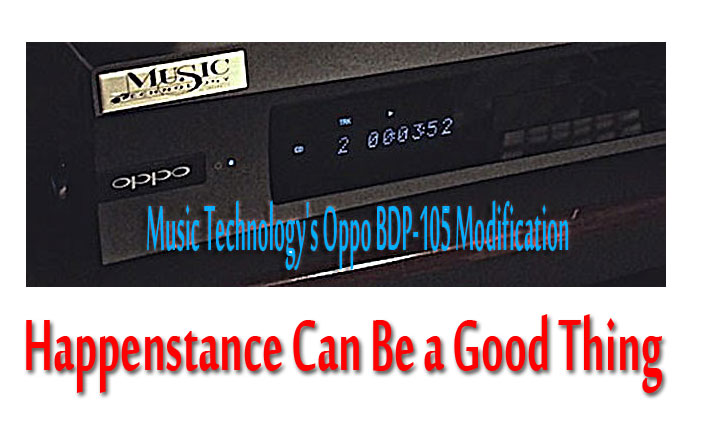
 I stumbled across the Music Technology (MT) modded Oppo BDP-105 by shear chance. I had no idea that the mod even existed until a recent visit to Music Technology for a ribbon tweeter replacement and a modification to a DAC. Bill Thalmann, one of the owners of MT mentioned he had recently modded an Oppo 105, was using it in his own system, and intended to market the mod. As many of you likely know, the stock Oppo 105 is a versatile player, and includes, among other things, the ability to play CD/SACD, DVD-A, and Blu-Ray discs. It has been widely reviewed with very positive results. This universal player has a host of features, including being able to serve as a worthy DAC, and can easily be used as such for computer audio with its asynchronous USB input.
I stumbled across the Music Technology (MT) modded Oppo BDP-105 by shear chance. I had no idea that the mod even existed until a recent visit to Music Technology for a ribbon tweeter replacement and a modification to a DAC. Bill Thalmann, one of the owners of MT mentioned he had recently modded an Oppo 105, was using it in his own system, and intended to market the mod. As many of you likely know, the stock Oppo 105 is a versatile player, and includes, among other things, the ability to play CD/SACD, DVD-A, and Blu-Ray discs. It has been widely reviewed with very positive results. This universal player has a host of features, including being able to serve as a worthy DAC, and can easily be used as such for computer audio with its asynchronous USB input.

Oppo’s website touts the BDP-105 in its stock form as a “Universal Audiophile 3D Blu-ray Disc Player and includes a ESS SABRE32 Reference Audiophile DAC, Headphone Amp & Asynchronous USB DAC, Stereo & Multichannel Analog Outs, and 4k Up-Scaling, 3D Playback, 2D to 3D Conversion.” But, as mentioned above it also happens to play a host of formats that many of us crazed audiophiles would likely want. But, the $64,000 question in my mind was how would the modded version of this baby perform using the digital audio formats I use most often, CDs and SACDs?
I was anxious to review the MT modded Oppo 105 player, particularly since the mod was performed by Bill Thalmann. I have had extremely positive experiences with Bill’s ability to repair the most complex high end equipment, and he has tweaked some of my gear with ad-hoc mods, with stellar results. So, when I need repairs that I can’t fumble through myself (which pretty much means most things), or if I want to mod something, I feel compelled to call Bill and take the hike from Baltimore to Springfield, Virginia. I always know the repairs will be done right, and any tweaks will likely result in discernable improvements.
In this case I was very curious to see if the Oppo 105 with MT’s mods could compete in any fashion with my reference player for nearly one fifth of its price. My prior experience with the prior top of line Oppo 95 was that it was a great universal player for the money, but not in any way in the same league as my reference Esoteric K-03 CD/SACD. However, the stock Oppo 105 is purportedly an improvement over the Oppo 95, so I was also intrigued to find out how the 105 in its modded form would compare to my experience with the Oppo 95.
Well, surprise, surprise, surprise…
Rather than keep you in suspense for the next fifteen minutes or so, I can tell you that the modded 105 in my view is in the same ballpark as the performance of my Esoteric in one significant way: it gets close to the Esoteric in shear musicality, even though, as expected, it does not beat the performance of the Esoteric overall. To me, that is still very impressive considering the price differential. No, I am not selling my Esoteric because I love it and think it is definitely near the top of the audio heap, especially given my budget. But, I can tell you that the Oppo 105 with the MT mod makes beautiful music like my Esoteric, and musicality is very high on my list of must haves. Plus the MT modded Oppo has a warm and smooth overall presentation much like that of vinyl.
A Bit About MT and its Owners
In contemplation of the Oppo 105 mod review, I asked Bill Thalmann how he got involved in audio repairs and mods and he relayed the following information. Bill started working professionally with audio electronics immediately upon getting out of the army in 1974. It was a hobby since age 12 when he started building Heathkits (from a vacuum tube CB transceiver to a 25” color TV). From an early age Bill read everything he could get his hands on that explained what was going on with this stuff. Working as a tech for several local hi-fi stores, he eventually met Lew Johnson and Bill Conrad as they were experimenting with a tube preamp of their own design. Bill Thalmann (Bill T.) sold them a few pieces of test equipment and ran some tests on their preamp (which tested very well) and struck up a friendship. When they made the decision to launch Conrad-Johnson (CJ), Bill T became CJ’s first employee, helped set up the company, trained personnel, and performed production testing, etc.
When the company grew, Bill T. became CJ’s technical director and helped with design work (mostly circuit board design, mechanical design and ancillary circuitry), and prototype development. Bill T. stayed with CJ for approximately 20 years. During that period, he started a repair operation to support Excalibur Audio in Alexandria, VA (Excalibur Technical Services), and split that off when the store folded around 1987 and renamed it Music Technology. This remained a part-time endeavor until 2000, when Bill left CJ to pursue MT full-time. At that time, Bill partnered with Doug Weisbrod, who also had decades of electronics experience and had been a technician at CJ for several years before leaving to join MT. The partnership has continued quite successfully for nearly 15 years.
Like Bill T, Doug began working on electronics at an early age (in the fourth grade as part of a Boy Scout program) starting with crystal radios. He later built larger antennas and it progressed from there. After learning about radios, he built his first guitar amplifier in high school (a Marshall Plexi input stage and a Fender Twin output stage).
In the mid 90’s Doug met a gentleman who had been performing paint work for CJ. Doug mentioned to him that he wanted to start an electronics company and build music equipment. The gentleman knew Bill Thalmann and suggested Doug call him, take him to lunch, and pick his brain. Doug called CJ one afternoon and asked to speak to Bill. They asked Doug if he was calling about the technician position, and he said well…yes. It was a great opportunity to learn from the best! And so the relationship began…
Music Technology has evolved into a resource for audiophiles and musicians with technicians specializing in almost the entire gamut of audio production and reproduction electronics. MT now has its sights set on formalizing its upgrade packages and developing new products for the audiophile community in areas where they feel they can contribute to the state of the art. In parallel, MT is developing a line of musical instrument electronics to complement the Talos Basic guitar amp that it designed and built several years ago, which met with critical acclaim and interest by some heavy hitters in the music industry.
MT’s staff consists of the following individuals who specialize in the areas listed next to their names:
Doug Weisbrod: Vacuum tube and solid state guitar amplifiers, guitar repair and high end electronics and product development.
Tim Leinbaugh: Tape decks (Reel to Reel and cassette), electronic keyboards, and digital processors and product development.
Corey Holland: Pro audio, solid state instrument amplification and vintage audio repair and restoration.
Mike Lederer: Loudspeaker repair, cosmetic restorations, and assisting with vintage electronic restoration and upgrades.
Bill Thalmann: High end and vintage electronic repair, restoration and upgrades, Apogee ribbon loudspeaker restoration, and product development.
Collectively, MT represents well over 100 years of experience.
The Talos Basicall-tube guitar amp was the first product that Bill and Doug built together at Music Technology. Being the guitar player, Doug developed the prototype and Bill designed the chassis, circuit boards and enclosure on his CAD system. From this experience, they saw that they were a good design team.
Bill and Doug decided to use their respective talents to design a new audio output stage and clock for the Oppo BDP 105, as it had strong demand and production numbers and there was plenty of room for improvement. Bill has great instinct when it comes to identifying weaknesses in high-end audio equipment and designed most of the circuit for the Oppo mod on his own. Doug spent the last three years researching capacitor design and materials, so he contributed to capacitor design and sourcing for the Oppo 105 mod.
Back to the Modd…What Does the MT Oppo 105 Mod Consist Of?
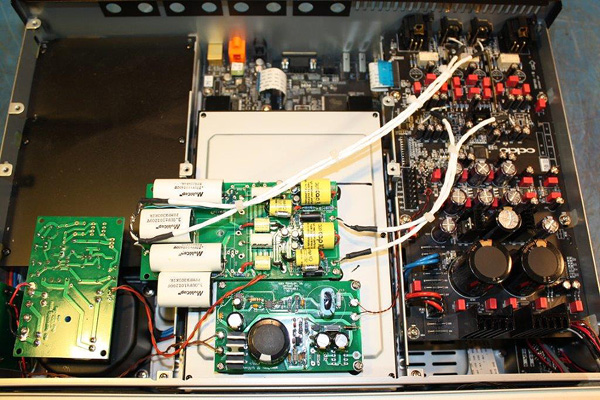
The MT Oppo 105 mod consists of the installation of MT’s Steady-Clock I hyper low jitter, hyper low-noise clock, which re-clocks the Oppo 105 ESS Sabre DACs at 80MHz and is powered by its own power transformer. The regulation circuits utilize supercaps of 1 Farad to achieve an improved performance level. The stock analog circuit is replaced with MT’s analog I/V converter/amplifier/filter. MT extended the bandwidth of the filter out to 55kHz as it simply sounded better to their ears. The analog module is also powered by its own power transformer and regulated power supply.
Bill Thalmann informed me that quality parts are used throughout, but only the unbalanced outputs were upgraded in the prototype that I received (which was Bill’s personal player), but the upgrade can be made fully balanced. From a design philosophy standpoint, MT aimed to make the sound of the Oppo a bit warmer, and more inviting with crystal clear top end and good soundstaging. They felt the stock player to not be bad sounding, but generally uninvolving. Digitally, MT felt the player has unmatched versatility, so bringing the sound up to a higher level seemed a no-brainer. The prototype had the multi-channel board removed to reduce the load on the Oppo power supplies. It can be left in and will function normally if installed, but the 2-channel outputs are where the MT analog module is output.
So How Does the Modded 105 Compare to the Oppo 95
Unfortunately, I did not have the Oppo 95 on hand to perform a head to head comparison, but one thing I can say for sure, based solely on memory the modded 105 sounded more musical than the 95. It was smoother and warmer and if you closed your eyes you may be tricked into thinking you were listening to vinyl.
Sweet Listening Pleasure
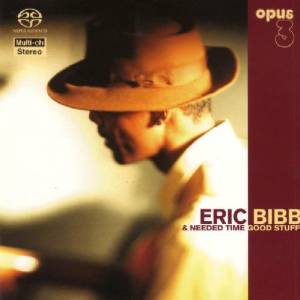 From the moment I turned the modded Oppo on I knew it was something special. It had all the dynamic attributes of CD/SACD, along with a smooth, warm and musical approach. Voices were to die for, with texture, weight and nuance one expects when dropping the needle on an LP. After a week of settling in, I got down to some serious listening and began with some awesome modern blues, Eric Bibb & Needed Time’s “Good Stuff” recording is a great hybrid SACD (Opus 3). From the first self-entitled track Good Stuff, all I could think was smooth, smooth, smooth. But, somehow the details emerged from a blacker and more solid backdrop. The most killer aspect was Bibb’s beautiful voice and the sweet effortless tone that was prevalent throughout the entire CD. On the second track Saucer n’ Cup, I noted I was hearing most of the details I had just heard when playing this SACD through my reference Esoteric K-03 player. Yeah it didn’t quite have all the same level of articulation and attack, sustain and decay of notes as the K-03, but the substance of the music was still all there and in a very musical presentation, and ohhhhh so warm and smooth I kept saying to myself.
From the moment I turned the modded Oppo on I knew it was something special. It had all the dynamic attributes of CD/SACD, along with a smooth, warm and musical approach. Voices were to die for, with texture, weight and nuance one expects when dropping the needle on an LP. After a week of settling in, I got down to some serious listening and began with some awesome modern blues, Eric Bibb & Needed Time’s “Good Stuff” recording is a great hybrid SACD (Opus 3). From the first self-entitled track Good Stuff, all I could think was smooth, smooth, smooth. But, somehow the details emerged from a blacker and more solid backdrop. The most killer aspect was Bibb’s beautiful voice and the sweet effortless tone that was prevalent throughout the entire CD. On the second track Saucer n’ Cup, I noted I was hearing most of the details I had just heard when playing this SACD through my reference Esoteric K-03 player. Yeah it didn’t quite have all the same level of articulation and attack, sustain and decay of notes as the K-03, but the substance of the music was still all there and in a very musical presentation, and ohhhhh so warm and smooth I kept saying to myself.
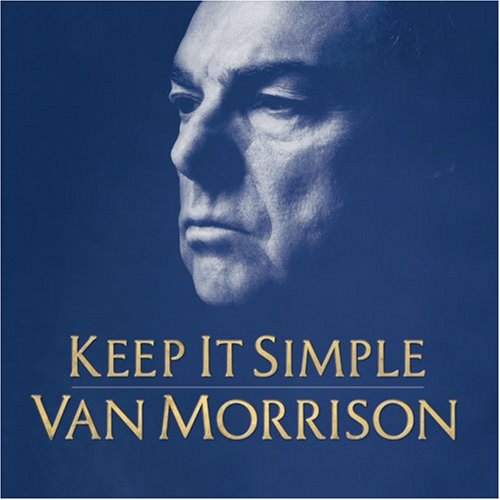 Next up on the listening agenda was Van Morrison, “Keep It Simple.” I pressed track 3, That’s Entrainment, which I have used for some other listening tests, so I am very familiar with every nuance of the song. The first thing that hit me was how clear, crisp, but very organic sounding the Oppo was. And Van’s voice was extremely smooth. I was hearing plenty of details, and the overall presentation was very musical. This was a common theme throughout my time with the MT Oppo.
Next up on the listening agenda was Van Morrison, “Keep It Simple.” I pressed track 3, That’s Entrainment, which I have used for some other listening tests, so I am very familiar with every nuance of the song. The first thing that hit me was how clear, crisp, but very organic sounding the Oppo was. And Van’s voice was extremely smooth. I was hearing plenty of details, and the overall presentation was very musical. This was a common theme throughout my time with the MT Oppo.
I tend toward the euphonic side of the spectrum and musicality is more important than ultra-detail. If you are like me in this preference, I suspect you will love this modded Oppo. Is the K-03 better, yes, but not five times better, which is about how much more you would have to pay for a new K-03. I kept jumping back and forth between the moddedOppo and the K-03, and while I could discern the improvements each time, I kept going back to the Oppo and thinking how much I liked the sound of it. It was so musical and enjoyable to listen to, and isn’t that what it is all about. No ear fatigue with this baby. In many ways I felt like I was going from digital to vinyl; a more relaxed presentation, and I really loved it.
After comparing many CDs in both players, I consistently noticed the same differences between the two players. The Esoteric clearly had a more refined and sophisticated sound, as it should for the price differential. I concluded that I missed the way the K-03 played with extended notes hanging in the air, and clearly portraying the attack, sustain and decay of notes. But, on the other hand, I really enjoyed the overall musicality of the MT modded Oppo and its vinyl-like sound. It had an intangible relaxed presentation that just drew you into the musical performance. While overall the K-03 was the winner in my book in terms of refinement of sound and life-like presentation, I decided perhaps it would be fairer to compare the Oppo to another well-respected player that was priced much closer to the Oppo and which had asimilar mod that was installed by MT, but sourced in part from another company.
Comparison of the Modded Oppo 105 to the Sony XA5400 with Vacuum State Electronics(VSE) Mod

As many of you may know, the stock version of the Sony XA5400 CD/SACD player has received rave reviews, along with its predecessors in Sony’s line of high-end players. MT previously was designated by Swiss company, Vacuum State Electronics (VSE), as an installer of VSE modifications for the Sony XA5400. While the Sony player received many accolades in its stock form, by all accounts it was purportedly better with the VSE mods installed by MT. Hence, it seemed like a perfect machine to compare to the Oppo. However, this was not a comparison I planned, it just happened by chance.
I borrowed the Sony from Bill Thalmann, as it was his previous personal unit which was up for sale at MT. I noticed it sitting on the “for sale” shelf and thought I would try it for my bedroom system, and perhaps pull the trigger if it was as good as all the press. I didn’t realize it had been modded until I asked Bill about the unit. Bill decided to sell the Sony because he was using the MT modded Oppo instead. I did a bit of research on the VSE mods after I borrowed the Sony and the reviews I read were all very positive. My initial impressions of the modded Sony were also positive. I noted a very relaxed musical presentation with a beautiful midrange.
The VSE mod performed by MT on the Sony unit essentially consisted of installing MT’s Steady-Clock I, the same one used in the Oppo mod, along with an analog section from VSE consisting of supply regulators and a new analog signal path that uses a proprietary opamp in a particularly interesting fashion. The analog section, like MTs for the Oppo, replaces the analog signal path from the DAC chips to the outputs.
I had the Sony on hand while reviewing the Oppo, so I figured why not do a head to comparison, especially since the mods were similar the Oppo. The base unmodded units are in the same ballpark from a price perspective, and Bill T. informed me the VSE mod would be in the $3k range, only about $1200 more than the Oppo. While overall I preferred the Oppo, the Sony had one characteristic that I loved, which was a beautiful engaging midrange. In the end I concluded that the Oppo just sounded more like live music on all the CDs that I listened to. 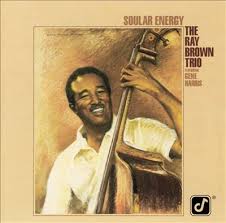 Interestingly, on SACDs both machines were much closer and the Sony seemed to up the ante to a higher level of performance. While I felt the Oppo was still better on SACDs, it was not nearly as much a difference as on CDs. More of the details in the music seemed to come through on SACDs played through the Sony that were also present on the Oppo. A perfect example of this closeness in sound characteristic was evident on Alison Krauss’ live 2 SACD set, Alison Krauss + Union Station Live. These SACDs have quite a lot of wonderful instrumentation. Throughout the entire 2 SACD set I noted much of the articulation of the instrumentation was present on both machines, but was a bit softer sounding on the Sony. Not nearly as much difference, however, as when I played CDs. This closeness in sound characteristics was also evident throughout my critical listening of The Ray Brown Trio’s wonderful SACD, Soular Energy, a great audiophile listening experience. I have this jazz instrumental recording on SACD and several audiophile album pressings, so have listened to it many dozens of times. Many of the nuances I am familiar with hearing came through on the both players, with a tad more articulation and “in the room” sound on the Oppo. However, the differences were much more subtle than when comparing the two machines with regular CDs.
Interestingly, on SACDs both machines were much closer and the Sony seemed to up the ante to a higher level of performance. While I felt the Oppo was still better on SACDs, it was not nearly as much a difference as on CDs. More of the details in the music seemed to come through on SACDs played through the Sony that were also present on the Oppo. A perfect example of this closeness in sound characteristic was evident on Alison Krauss’ live 2 SACD set, Alison Krauss + Union Station Live. These SACDs have quite a lot of wonderful instrumentation. Throughout the entire 2 SACD set I noted much of the articulation of the instrumentation was present on both machines, but was a bit softer sounding on the Sony. Not nearly as much difference, however, as when I played CDs. This closeness in sound characteristics was also evident throughout my critical listening of The Ray Brown Trio’s wonderful SACD, Soular Energy, a great audiophile listening experience. I have this jazz instrumental recording on SACD and several audiophile album pressings, so have listened to it many dozens of times. Many of the nuances I am familiar with hearing came through on the both players, with a tad more articulation and “in the room” sound on the Oppo. However, the differences were much more subtle than when comparing the two machines with regular CDs.
So, What Were the Differences on Regular CDs?
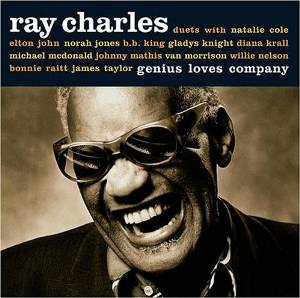 The Oppo Sony regular CD shoot-out results were clearly reflected when listening to Ray Charles’ CD of duets, Genius Loves Company. The fifth track, Fever, opens with a distinct bass line, which just seemed to have more resonance with the Oppo. But, when it came to voices the Sony held its own and presented Natalie’s Cole voice with a lovely natural presentation. It just did not have the dynamics of the Oppo, so some of the instrumental details were lost in the background. With the Oppo they were more obvious. Track 6, Do I Ever Cross Your Mind, begins with a guitar intro. Through the Oppo the guitar sounded more like it was in the room and like a live instrument than through the Sony. Bonny Raitt’s vocal entry sounded great through both players, with a slight edge to the Sony. I kept on going back and forth to make sure which I liked better, and concluded the naturalness of the Oppo got the definite edge. The Oppo was musical, warm and still retained all the details. Going to the Sony some of details were lost. It was still enjoyable and musical but the dynamics/micro-details were not as prevalent as through the Oppo. The loss of those details, and layers of instruments, and the laid back overall presentation of the Sony took some of the life out the listening experience and made it sound less like live music than the Oppo. These same differences were evident throughout my tests of numerous CDs.
The Oppo Sony regular CD shoot-out results were clearly reflected when listening to Ray Charles’ CD of duets, Genius Loves Company. The fifth track, Fever, opens with a distinct bass line, which just seemed to have more resonance with the Oppo. But, when it came to voices the Sony held its own and presented Natalie’s Cole voice with a lovely natural presentation. It just did not have the dynamics of the Oppo, so some of the instrumental details were lost in the background. With the Oppo they were more obvious. Track 6, Do I Ever Cross Your Mind, begins with a guitar intro. Through the Oppo the guitar sounded more like it was in the room and like a live instrument than through the Sony. Bonny Raitt’s vocal entry sounded great through both players, with a slight edge to the Sony. I kept on going back and forth to make sure which I liked better, and concluded the naturalness of the Oppo got the definite edge. The Oppo was musical, warm and still retained all the details. Going to the Sony some of details were lost. It was still enjoyable and musical but the dynamics/micro-details were not as prevalent as through the Oppo. The loss of those details, and layers of instruments, and the laid back overall presentation of the Sony took some of the life out the listening experience and made it sound less like live music than the Oppo. These same differences were evident throughout my tests of numerous CDs.
I tried to put my finger on what was missing with the Sony and ultimately came to the conclusion that it was the attack, sustain and decay of notes that was more clearly discernable through the Oppo. From CD to CD, I noticed similar distinctions in clarity and life-like presentation, with the Oppo being the articulation champ, trumping the Sony in overall musicality. The Sony was very good, but the Oppo was routinely better. Again, the Sony shined in the midrange, but overall the Oppo was more musical. The differences were so consistently apparent that I did not feel the need to repeat them for each of the CDs I listened to using both machines. My listening notes were essentially the same. In the end I felt the Oppo was the clear winner.
Conclusions:
While I did not have the luxury of starting with an Oppo 105 in its stock form, judging from my prior experience with the Oppo 95, the MT mod seemed to transform a decent universal player with lots of features to a state of the art giant killer of a machine. Upon first listen, my mouth just hung open. My initial impression was that the modded Oppo gave cds a vinyl-like sound; warm and smooth and extremely musical, and it just improved as it settled in from transport. While the Oppo is not as refined or articulate as my reference CD/SACD player, it is in the same ballpark and competes with my reference in terms of musicality. This is quite impressive in my book given that my reference is almost five times more expensive than the base price of the Oppo ($1199-$1299) plus the $1800 mod. In my view, the MT modded Oppo sounded more like live music than the very well respected Sony XA 5400 CD/SACD player with a similar mod, especially when playing regular CDs.
I would say the MT modded Oppo is definitely a no-brainer! It is certainly a mod you may want consider, since, from my perspective, at its $1800 price tag, it may be the best money an audiophile could spend, especially if you already own an Oppo 105. I was so impressed that I am planning on buying an Oppo 105 and having it modded by MT for my second system. I can’t wait for it to return to my listening room.


lewis dardick
Specifications:
Unbalanced Installation: $1,800
Balanced Installation: $2,400
Music Technology
5418 Port Royal Road
Springfield, VA 22151
Phone: 703-764-7005
Fax: 703-764-0079
Website:http://musictechnology.com/products
2 thoughts on "Music Technology’s Oppo BDP-105 Modification"
Leave a Reply
Stereo Times Masthead
Publisher/Founder
Clement Perry
Editor
Dave Thomas
Senior Editors
Frank Alles, Mike Girardi, Russell Lichter, Terry London, Moreno Mitchell, Paul Szabady, Bill Wells, Mike Wright, and Stephen Yan,
Current Contributors
David Abramson, Tim Barrall, Dave Allison, Ron Cook, Lewis Dardick, John Hoffman, Dan Secula, Don Shaulis, Greg Simmons, Eric Teh, Greg Voth, Richard Willie, Ed Van Winkle, Rob Dockery, Richard Doran, and Daveed Turek
Site Management Clement Perry
Ad Designer: Martin Perry






I am Bill Thalmann’s wife, and he passed away on January 21, 2024. Just came across this review from 2015, and it warmed my heart. Will keep it always.
I’m so sorry for your loss, Mrs. Thalmann. Bill was an excellent designer and even a greater person. The audio community mourns your loss.
Clement Perry